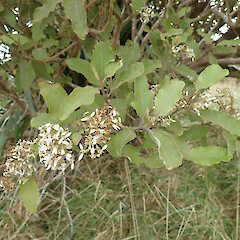Olearia albida
Synonyms
Eurybia albida Hook.f., Olearia albida (Hook.f.) Hook.f. var. albida
Family
Asteraceae
Flora category
Vascular – Native
Endemic taxon
Yes
Endemic genus
No
Endemic family
No
Structural class
Trees & Shrubs - Dicotyledons
NVS code
The National Vegetation Survey (NVS) Databank is a physical archive and electronic databank containing records of over 94,000 vegetation survey plots - including data from over 19,000 permanent plots. NVS maintains a standard set of species code abbreviations that correspond to standard scientific plant names from the Ngä Tipu o Aotearoa - New Zealand Plants database.
OLEALB
Chromosome number
2n = 324
Current conservation status
The conservation status of all known New Zealand vascular plant taxa at the rank of species and below were reassessed in 2017 using the New Zealand Threat Classification System (NZTCS) – more information about this can be found on the NZTCS website. This report includes a statistical summary and brief notes on changes since 2012 and replaces all previous NZTCS lists for vascular plants.
Please note, threat classifications are often suggested by authors when publications fall between NZTCS assessment periods – an interim threat classification status has not been assessed by the NZTCS panel.
- Conservation status of New Zealand indigenous vascular plants, 2017 . 2018. Peter J. de Lange, Jeremy R. Rolfe, John W. Barkla, Shannel P. Courtney, Paul D. Champion, Leon R. Perrie, Sarah M. Beadel, Kerry A. Ford, Ilse Breitwieser, Ines Schönberger, Rowan Hindmarsh-Walls, Peter B. Heenan and Kate Ladley. Department of Conservation. Source: NZTCS and licensed by DOC for reuse under the Creative Commons Attribution 4.0 International licence.
2017 | Not Threatened | Qualifiers: DP
Previous conservation statuses
2012 | Not Threatened
2009 | Not Threatened
2004 | Not Threatened
Brief description
Spreading small coastal tree of northern North Island with grooved flaky bark and bearing leathery light green wavy leaves that have a white underside. Twigs grooved on the upper surface. Leaves taper towards the pointed tip. Some of the hairs on the stems are star-shaped. Flowers white, in large clusters.
Distribution
Endemic. Aotearoa / New Zealand, Te Ika a Maui / North Island - northern portion of island from Ahipara sporadically to the Kaipara south to north Taranaki, also locally present on the islands and shoreline of the Hauraki Gulf, Coromandel Peninsula and Tairawhiti / East Cape.
Habitat
Olearia albida is a coastal species favouring coastal headlands where it often grows on slip scars, rubble slopes or in canopy gaps amongst other coastal forest trees. Common co-associates include Entelea arborescens, Kunzea robusta, Metrosideros excelsa, Leptospermum hoipolloi, Myoporum laetum, Olearia angulata, O. furfuracea, Pomaderris kumerahou, P. rugosa, Vitex lucens, Veronica spp., Pittosporum crassifolium, and around Tairawhiti P. ralphii. Olearia albida usually grows in small stands of three or more trees in places suggesting that germination has occurred following some disturbance event e.g, slip, fire, boulder fall.
Threats
Never a common species Olearia albida has hitherto not been considered ‘At Risk’ or ‘Threatened’. It is now recognised that over large parts of this species range it is not only uncommon, but also that it is scarcely recruiting, and that some populations are in decline as a consequence of weed invasion, animal browse pressure, land development and coastal erosion. Therefore, re-evaluation of its conservation status is necessary. Currently there are no population estimates for the species. It is however known to be widespread, and while biologically sparse in its occurrences, it may on occasion be locally abundant. On the basis of these observations and limited counts of adults in some parts of this species range suggests a population of ≤ 10,000 mature individuals.
Recent investigation of populations within the species strong holds such as around greater Auckland has discovered that at many sites only mature trees are present, recruitment is either absent or limited, either as a consequence of competition from weeds such as Pampas grass (Cortaderia jubata, C. selloana), gorse (Ulex europaeus), bone seed (Osteospermum moniliferum), Agapanthus praecox subsp. orientalis, smilax (Asparagus asparagoides), and Asparagus scandens or forest succession. In these areas decline rates of 10-30% over the next 10 years have been predicted (Simpkins et al. 2022) Coastal resort development has also hastened declines through habitat loss and the further influx of weeds stemming from garden water dumps and cultivation escapes. Olearia albida is also vulnerable to coastal erosion, roadworks, and direct browse pressure from livestock, feral goats (Capra hircus) and possums (Trichosurus vulpecula).
Etymology
olearia: Named after Johann Gottfried Olearius, a 17th-century German scholar, writer of hymns and author of Specimen Florae Hallensis
albida: From the Latin ‘alba’, meaning somewhat white
References and further reading
Simpkins, E., Woolly, J., de Lange, P., Kilgour, C., Cameron, E., Melzer, S. 2022: Conservation status of vascular plant species in Tāmaki Makaurau / Auckland. Technical Report 2022/19, Auckland Council, Auckland.
NZPCN Fact Sheet citation
Please cite as: de Lange, P.J. (Year at time of access): Olearia albida Fact Sheet (content continuously updated). New Zealand Plant Conservation Network. https://www.nzpcn.org.nz/flora/species/olearia-albida/ (Date website was queried)









